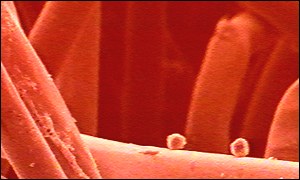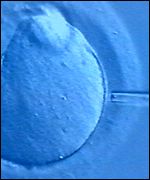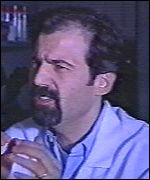BBC News . 13 january 2002
 Stem cells have the potential to treat diseases |
 Scientific first: An egg injected with a skin cell |
 Mr Cibelli: Embryo science is "extremely delicate" |
A man left paralysed after a cycling accident is hoping pioneering methods of human cloning will give him a new lease of life without disability.
Texan doctor Judson Somerville has volunteered to give cells from his body to scientists aiming to cure him through human embryo cloning.
His story features in the first of four programmes, beginning on Sunday, on life and human experimentation, aptly entitled How To Build A Human.
The BBC2 landmark series looks at the ground-breaking steps being taken
in human development, from recreating life to ways of altering the ageing
process.
The series covers four areas of advancement in human technology; creation, genetic predictions, gender alteration and the ageing process.
Cutting-edge images give a futuristic and very visual portrayal of the latest discoveries in science.
Global notoriety
And it offers a scientific and television first with footage of scientist José Cibelli, head of research at Advanced Cell Technology, actually cloning the first human embryo.
Mr Cibelli achieved global notoriety when he and his team made the first
ever success in human cloning in October last year.
His quiet, studied persona is portrayed against the background of the phenomenal leaps he wants to take in human creation technology.
"If we can fulfil this dream, we can change the lives of so many people," he says, of his controversial work.
The programme mixes futuristic technology with the everyday life stories of those who find themselves in the medical spotlight.
Guinea pig
Mr Somerville, a father-of-two who was a sporting fanatic before his accident in 1990, is Mr Cibelli's "guinea pig".
The programme, in a suspense-filled, fly-on-the-wall style, follows Mr
Cibelli as he goes about the business of trying to make an embryo clone
of Mr Somerville.
His aim is to be able to use cells from the cloned embryo - the vital stem cells - to eventually repair Mr Somerville's broken spine.
To make the series, the programme makers were given exclusive access to José Cibelli and Mr Somerville, who proved a willing patient.
"I come from a long line of pioneers, risk takers. There's no new frontier for me, they're not going to send me to Mars anytime soon and I'm willing to take the risk to potentially help myself and to help other people," he says.
It also introduces Sara Waddington, a mum-to-be from England, who is due to give birth to triplets.
The natural form of cloning in her body is contrasted with the efforts being made by Mr Cibelli.
Her triplet's conception is also revealed as a unique science - but one controlled by nature.
Viewers are shown with the use of vivid graphics how her fertilised egg split into three identical embryos.
Forever young
The three other programmes in the series promise to be equally enthralling.
The second looks at DNA and examines how our genes go to make up the
people we become - both physically and mentally.
The Secret of Sex puts gender changing under the microscope.
Finally, Forever Young looks at the wish to live forever, or at least longer than our existing lifespan. This programme picks out some of the most bizarre efforts people will go to, to enhance their longevity.
In all the four programmes set out to explore how the science fiction
of today can become the everyday practice of tomorrow.